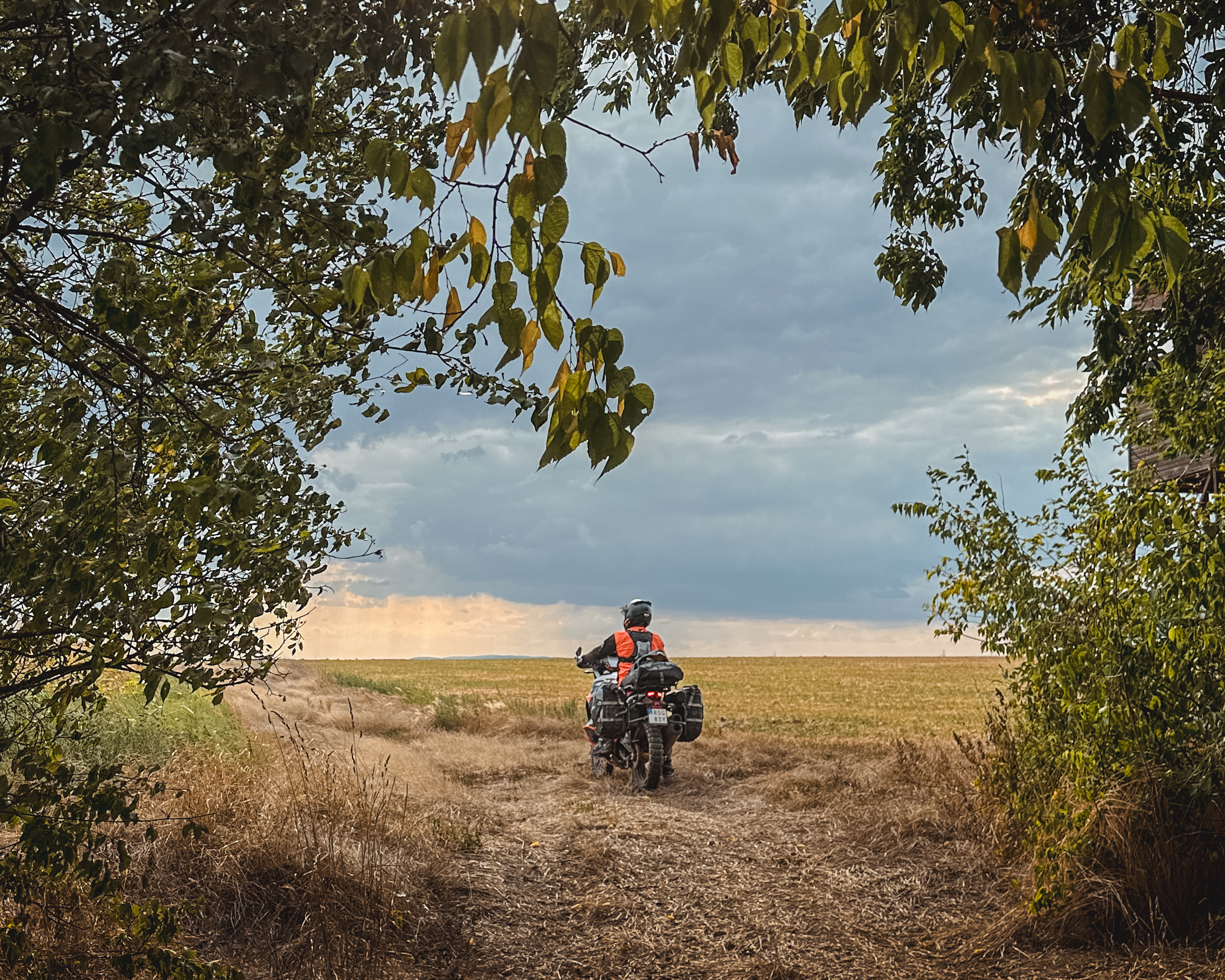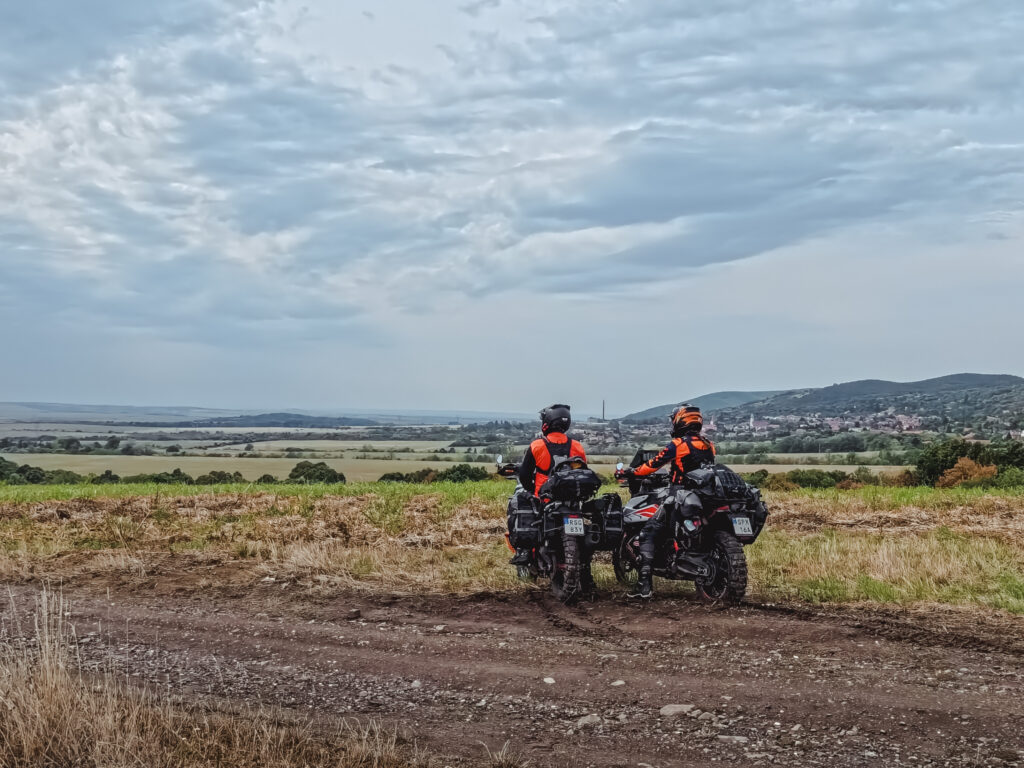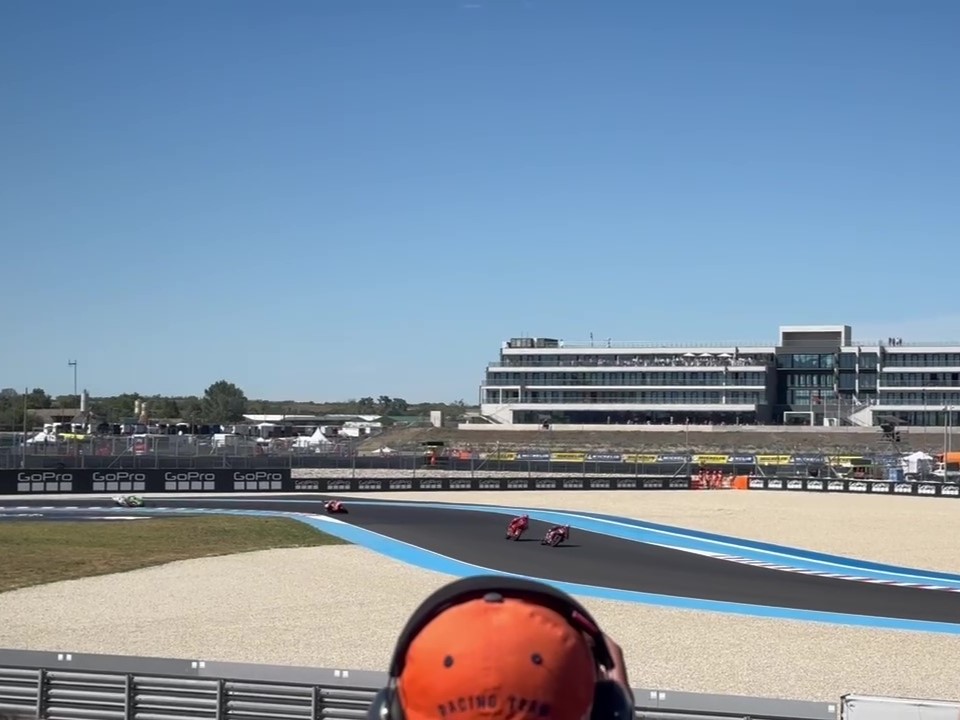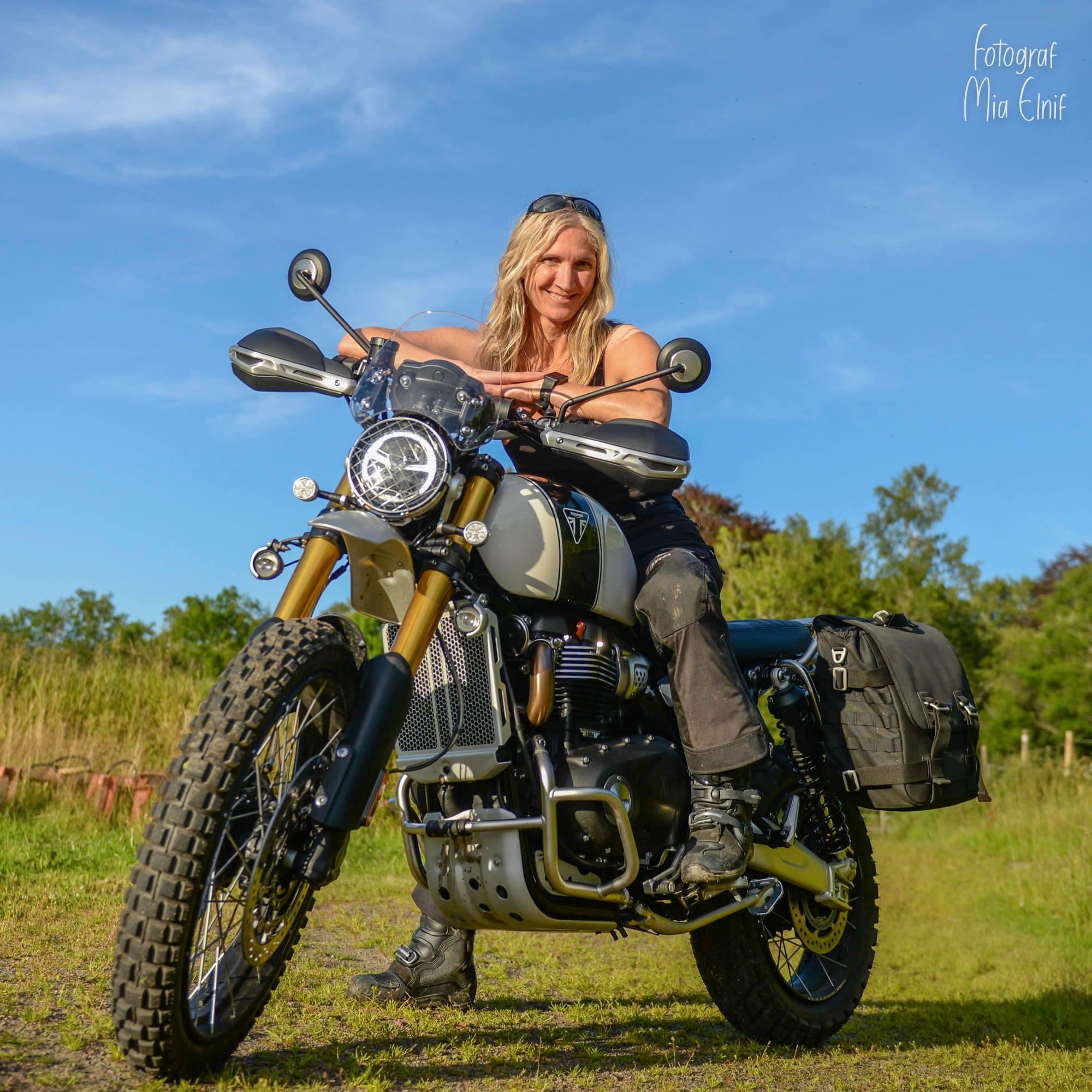From dream to reality – my road to the KTM Adventure Rally in Romania

In 2023 the rally was held in Lillehammer, Norway, where my partner Martin and two of our friends took part. I followed their progress from home, and once the rally was over I joined them by train in Lillehammer and rode along for a stretch in Norway before heading back home. Somewhere along the way a seed was planted, and I told Martin: “Next year I’ll get my motorcycle licence, and the next time you go to a KTM Rally I’ll be there too – on my own bike.” Martin was somewhat sceptical, but he was proven wrong. That is exactly how it turned out.
The journey begins
Our trip started in mid-August at home in Borås, taking us first to Poland on the Karlskrona–Gdynia ferry. The first few days were mostly transit, since we figured we could always return to northern Poland another time as it is “so close”. A quick stop in Warsaw, two nights in Kraków with the old town and beer as the main attractions, and then it was time to head properly south, sticking to winding tarmac and enjoyable gravel.
Route planning had begun back in January, and became a mix of tasty roads we had discovered online or through Google Street View, later tied together with Stegra.io. We wanted to include a bit of gravel riding before the rally, but above all we aimed to stick to tarmac to avoid unnecessary injuries – to ourselves or to the bikes. More on how that worked out later…
“Won’t you get tired of riding a motorbike? – that was one of the questions I got when telling friends and family that Martin and I were heading off on a three-week motorcycling holiday in Eastern Europe, which in the end would turn out to cover almost exactly 6,000 kilometres.”
Slovakia and the serpentine roads
Next up was Slovakia, and the Tatra Mountains offered us our first proper mountain roads. In central Slovakia I had found a gravel track with switchbacks and ravines that we simply had to ride – and we were glad we did. It was a magical loop along a narrow, partly washed-out gravel road. The kind of track where you wouldn’t expect to meet another vehicle, but of course we did – twice. The second time was even a lorry in the middle of the tight switchbacks, and all we two surprised Swedes could do was step aside and laugh.

After Slovakia the natural next destination was Hungary, and heading south we decided to try a section of the TET (Trans European Trail) just after the town of Esztergom. It started out beautifully, with sunshine and dry meadows, but as it had rained heavily in the days before, it soon turned into a slippery challenge in silty beech forests. We made it through, though not without some drama (mostly from me), and eventually emerged onto fine gravel roads alongside fields of sunflowers. For a while the pace picked up again – until suddenly we found ourselves in a dip with deep, loose sand. Caught off guard, we both ended up dropping the bikes within seconds of each other. Martin was fine, but I managed to hit the handlebar with my thigh and stayed down for a moment before carefully wiggling my toes to check that nothing was broken. Luckily it was just a muscle bruise, though I would later discover a haematoma worthy of its name. Well, what is a trip without a few challenges – or in this case, bruises.
MotoGP Live
The main goal of the trip was, of course, the KTM Rally – but we had a stroke of luck with the timing as we passed through Hungary. Both Martin and I follow MotoGP, and the weekend before the rally MotoGP came to Hungary and the Balaton Park Circuit. There was no question about it – we bought tickets and booked accommodation on the southern side of Lake Balaton.
We missed Friday’s sessions, but on Saturday and Sunday we got to see prime-time racing from our seats overlooking corners five and six. Highlights included Acosta on the factory KTM taking second place in Sunday’s race, witnessing Martín’s overtake on Marini first-hand, and of course the sheer joy of watching fast bikes in action.

KTM Adventure Rally – Sibiu, Romania
When Sunday’s race was over it was time to head for Romania. We rode for a few hours in the dark that evening to shorten the distance to Sibiu for Monday, as we wanted to arrive in good time for check-in and tyre fitting. Martin had experienced it before, but it’s still an impressive sight when the paddock camp comes into view: KTM flags and bikes everywhere, happy people, the faint smell of engines and a strong sense of anticipation in the air.
Day one – a reality check
Check-in, room allocation, number plates and goodie bags all went quickly. This was when reality really began to sink in. We were here now. I was here now. My seemingly impossible goal from 2023 had actually been achieved, as I slipped into the orange jersey from the goodie bag. The one that read “KTM Adventure Rally Romania 2025” on the front, and had a large “RIDER” print across the back. I’m not exaggerating when I say I felt a proper thrill in that moment. 250 cheerful KTM riders in one place, plus plenty of official KTM staff.
Monday evening began with dinner and the riders’ briefing. During the briefing we were told that this year’s rally would be on a completely different level compared with previous ones. As they said – “Norway and Portugal will be nothing compared to this.” That was about the point when my stomach turned and I began to grasp what I had signed up for. One of the speakers, also a co-organiser of the event, was the founder and main organiser of the hard enduro race Red Bull Romaniacs. According to him, it wouldn’t be too difficult – but the twinkle in his eye suggested otherwise.
One of the best things about these rallies is that you get to hang out, chat and, above all, ride with KTM staff. We had the pleasure of sitting next to KTM ambassador Greg Gordinne at dinner, chatting about previous rallies, gearing down 790s and, naturally, Romaniacs. Ambassador Johnny Aubert was there as well, and the star names at this rally were Dakar RallyGP winner Daniel Sanders and Rally2 class winner Edgar Canet.
Of course there was some talk about KTM’s finances over the past year, but the mood was upbeat and it was clear there was strong confidence in the future from both KTM staff and riders alike. As usual the evenings began with a bit of fun – I was even called up on stage as one of thirteen female rally participants to take part in a quiz. After the briefing it was dinner, and eventually time to turn in.
Tuesday – Romaniacs for real
Shortly after half past seven on Tuesday morning there was a long queue of riders waiting to set off beneath the Red Bull arch. Each bike was fitted with a GPS tracker, equipped with SOS capability, and once that was installed it was time to roll. Martin and I rode as “self-navigating”, though there were also guided groups for those who preferred that option.
Tuesday started off gently with gravel roads across fields outside Sibiu, some deeper water crossings and enjoyable riding in beech forests. Soon enough, though, it began to climb steeply. Very steeply. As our Swedish friend Peter put it – “That was 1,200 metres of climbing in a single ditch.” A very apt description, since the trail was a U-shaped two-metre-wide gully, half of which consisted of an even deeper rut filled with fist-sized rocks. Grip and spirits were high, so it was just a matter of zig-zagging from side to side and keeping the pace up. Both Martin and I were surprised at how well I managed, and had it not been for the final and steepest section being blocked by bikes lying down or waiting, I would have cleared the whole climb in one go.
As you can probably imagine, stopping mid-climb meant I lost all momentum – and trying to set off again on what felt like a 45-degree slope that only grew steeper was anything but easy. I made some progress, but eventually slipped into the rut and dropped the bike. My knight in shining armour (Martin, of course) scrambled down the slope, moving from tree to tree until he reached me. After spinning away some of the worst rocks and digging the rear wheel into the loam like a Tyrannosaurus Rex’s legs, he managed to find traction and haul my 790 out of the rut. What a man!
Much of Tuesday was spent tackling steep ascents littered with rocks the size of grapefruits, but one of the highlights – quite literally – was reaching the ridge above Sibiu and seeing the view for the first time. From there it was downhill again, on equally washed-out tracks with occasional detours weaving between fir trees. The up-and-down cycle continued in much the same fashion, and I honestly lost count of how many times I hit the deck that day. For context: Tuesday’s route was 140 kilometres long, and for most riders it took eight to nine hours to complete. The explanation came that evening when it was revealed that large sections of Tuesday’s course followed the exact tracks of that year’s Romaniacs. In other words: hard enduro terrain. Suddenly I felt a lot better about barely managing to get through it at all.
One participant we met on the trail told us he’d ridden five European Rallies, and this was by far the toughest. KTM rallies usually offer two options – an easy route and a hard one. The so-called “easy” tracks in Romania were roughly equivalent to, or just below, the hardest breakouts of previous rallies. Imagine, then, what the “hard” tracks were like this year. We didn’t even attempt them, but we’ve seen photos and videos of the more technical sections – and they were certainly no joke.
Wednesday – crashes and stubbornness
Wednesday kicked off just like Tuesday had ended: steep climbs up washed-out gullies strewn with big rocks. Somewhere along the way I toppled over again, this time hitting a sharp stone square on the same thigh that had taken a beating back in Hungary. Ouch. My spirits were still high though – barring the occasional overheated and hungry grumble. This was where stubbornness began to set in. Even though I needed frequent pauses, even though I had to pick up my dropped 790 more times than I care to admit, I restarted the bike every time and kept going. All this despite my thigh hurting so badly it was difficult to stand on the pegs, despite twisting my left ankle and bruising my right big toe rather badly. Thank heavens for proper boots (in my case, Alpinestars Tech 7), otherwise I’d have had some very real fractures.
When it comes to motorcycling in Romania, there are two famous roads everyone talks about: the Transfăgărășan and the Transalpina. Wednesday’s ride finished with a long stretch of tarmac, but I doubt anyone minded – the scenery and hairpins of the Transalpina were a joy. That night’s accommodation, dinner and briefing took place in Rânca – a ski resort perched on the summit of the Transalpina.
Thursday – the final stage
The last riding day also began on the Transalpina, but soon turned back onto gravel. This was perhaps the most surprising stage for me – not because of the riding itself, but because everyone actually did as we’d been asked. At the previous night’s briefing we had been told we would ride through a nature reserve, with a strict speed limit of 30 km/h. Remarkably, everyone respected it. The result was a long procession of KTMs of every shape and size, snaking their way through the Romanian mountains.
Once we descended from the Transalpina, the route opened up into sweeping gravel roads in a valley with a river meandering through the middle. “Finally, some normal gravel,” I thought, and let the pace pick up. After a break – during which we tried, unsuccessfully, to help a Danish rider with a puncture when Martin’s compressor gave up – we continued on the flowing tracks. It was all going brilliantly until we hit one final climb, again with washed-out sections and big rocks. By then I had built up some speed, so the climbs went much better than earlier in the week. But my thigh had really had enough by this point. After riding a hundred metres at a time before stopping to shake it out, we eventually decided to turn back and take the tarmac. In hindsight it was the right choice, though it meant we missed the final special stage: the chance to tackle the infamous finish hill from Red Bull Romaniacs. The actual hill. Quite a few riders managed it, and at the closing dinner the fastest rider to conquer it (outside of KTM’s own professionals) was, naturally, awarded a prize.
That evening, several awards were handed out – including to the participant who had owned the most KTMs, the one riding the oldest KTM at the rally, the KTM with the highest mileage, and finally the one who had ridden the furthest to get there. That last honour went to a rider we’d spoken to a lot during the rally. Originally from Switzerland, he had been living and working in Gothenburg before quitting his job and setting off homeward on his bike. Not directly, though – he went via Georgia before riding on to Sibiu. Afterwards he would continue to Switzerland. Quite the journey. And the prize? An all-inclusive trip to Colombia for a rally there, bike hire and fuel included. Well deserved, Robert!
For me, the KTM Rally was brutally tough, at times almost unbearable, incredibly instructive – and absolutely wonderful.
The road home
After the rally we had nine unplanned days ahead of us before catching the train home from Innsbruck. No schedule, just the freedom to decide as we went along. Given how much harder the rally had been than expected, we treated ourselves to a rest day at an AirBnB with a pool. Unplanned, but very much needed. That was the beauty of the return journey – no fixed plans, so we could take each day as it came.
The next country was Serbia, where we mostly stuck to twisty tarmac. In Bosnia and Herzegovina we made time for more gravel, and with a few days’ rest in the bank, tackling washed-out climbs and descents with all our luggage went much better. It was also impossible not to notice that we were riding through lands scarred by war not all that long ago. Several villages still bore houses with facades marked by bullet holes. In light of current events, those moments of sobering reflection were not at all unwelcome – if anything, they added a strong sense of gratitude for what we have today.
The Balkan countries offered by far the best scenery and gravel riding outside the rally itself, and we have both promised ourselves we’ll be back before too long. There’s simply too much to see not to return. We rounded off the trip with another rest day on the Croatian island of Lošinj, before the final push home. We had booked the night train from Innsbruck to Hamburg – the type that carries both motorbikes and cars – and before reaching Innsbruck we rode through Slovenia and spent a night in Austria. The train ride went smoothly (pun intended), and on Sunday morning we arrived in Hamburg. 650 kilometres later we were on the final stretch, and even though we rode all day, those last miles felt fantastic. We were both happy, deeply satisfied with the adventure – and still not tired of riding.
“Will it be a while before you feel like riding again once you’re back home?” The very next day after we got home, I was back on the bike – with a big grin on my face.
Lessons learned
One important thing for us – and always a good idea – was to have the bikes in top shape before departure. We checked them from A to Z, and both had been serviced by our local KTM dealer just before the trip. In practice, we had no major technical problems – nothing beyond what you’d expect. We both ran tubes in our tyres, and even the second-hand tyre was fitted with fresh tubes.
Another thing that worked well was building flexibility into our planning. We had an idea of how to get there and where to stay, but changed things along the way – which only made the adventure more alive. Likewise after the rally, when we had nine unplanned days, that freedom allowed us to take a rest day we hadn’t originally planned for, as both of us were more exhausted than expected.
And finally: in Sweden, road signs warn of wildlife. Further south, you’ll find warning signs for cows. Take them seriously – there really are cows everywhere, and they don’t move for you.
Will I do this again? Oh yes. Without a doubt. Now we’re just waiting to find out where the 2026 Rally will be, so we can book it in.
Tyres
I rode all 6,000 km on a new Pirelli MT 21 Rallycross front. For the road down to and back from the rally I used a single Bridgestone Battlax AX41 rear, and during the rally itself I had a Michelin Anakee Wild on the back of my 790. Martin’s 1290 started out with a used AX41 front, which he then swapped for a Mitas Enduro Trail XT+ Dakar – and that took him through the rally and all the way home. During the rally he ran a Mitas Enduro Trail XT+ rear (not the Dakar version), but on the road down and back he also had an AX41 rear. As a relative beginner, I appreciate every bit of grip I can get on gravel, and I was genuinely happy with the MT21/Anakee Wild combo for the rally. The AX41 rear is a dream on tarmac and, in our view, works brilliantly on gravel too. Martin tried the Mitas tyres for the first time and was more than pleased with his choice.
Best part of the trip: Can I say everything? Apart from the rally itself, it has to be the views in Romania and the Balkans – and above all experiencing the journey together with Martin, each on our own bike.
Worst part of the trip: Bruises the size of Hungary, and both our cruise controls giving up just as we had to blitz the motorway from Hamburg to Borås in a single day.
Packing tips: Always carry tools and gear to fix a puncture yourself, depending on whether you’re running tubes or tubeless. Pack clothes for a week, even for longer trips, and either book accommodation with a washing machine or bring travel detergent for handwashing in sinks. We always carry one or two portions of canned meals plus a heater – handy for when there’s no restaurant or shop nearby.

